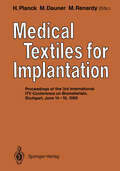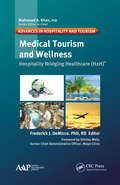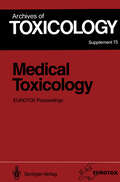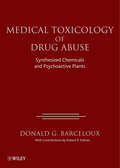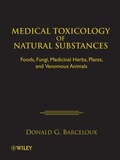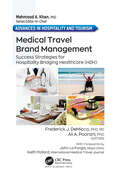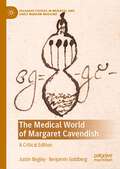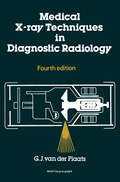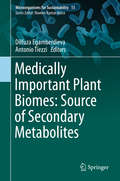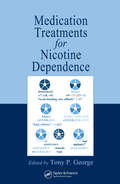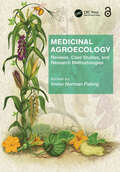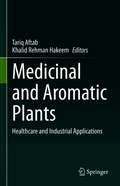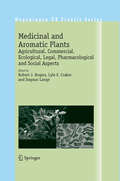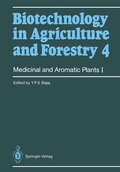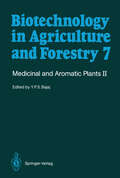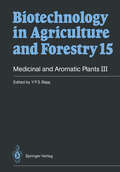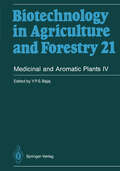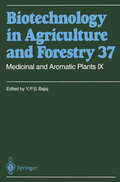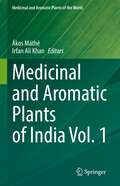- Table View
- List View
Medical Textiles for Implantation
by Heinrich Planck Martin Dauner Monika RenardyTriennial the Division of Biomedical Engineering of the Institute of Textile Technology and Chemical Engineering, Denkendorf, is organizing conferences on specific topics in the field of polymeric materials for use in the biomedical areas. The aim is to bring together scientists from allover the world working on this speci fic topic, to present the newest state of the art and to discuss their problems in a more concentrated atmosphere and at last to create and intensivate their cooperation. Following two conferences on "Polyurethanes in Biomedical Engi neering" (1983 and 1986), the Institute of Textile Technology and Chemical Engineering set a theme, which is very closely related to its own task: "Medical Textiles for Implantation". As technical materials, textiles can be classified in two fields of application: - first, textiles used for highly flexible, strong, but only tension load bearing systems, e.g. tows; - second, textiles manufactured to flat shaped devices to separate two regions more or less semipermeable, e.g. clothing; - a combination of both are reinforced systems like tubular fabrics e.g.; here pressure load will be transformed to tensile load, the separation may be performed by a coating. In the biological systems the classification can be used in the same manner: - Tension load bearing structures are ligaments and tendons, semipermeable separation is realized by cell membranes as well as by cell layers, for example the skin. - The combination of both of the principles can be found for example in arteries and the trachea.
Medical Tourism and Wellness: Hospitality Bridging Healthcare (H2H)
by Frederick J. DeMiccoMedical Tourism and Wellness: Hospitality Bridging Healthcare (H2H) takes a systems approach to examining the growing field of medical tourism, one of the field’s hottest niches, with billions of dollars spent each year. This important book fills the need for a modern management book that looks at medical tourism in depth from a medical and hospitality operational management perspective. Growing numbers of people are going abroad to find affordable quality medical care for both necessary and cosmetic medical services. When they require surgery or dental work, they combine it with a trip to the Taj Mahal, a photo safari on the African veldt, or a stay at a luxury hotel—or at a hospital that feels like one—all at bargain-basement prices. The book takes a comprehensive look at medical tourism, covering such topics as: The history of medical tourism Why patients/tourists decide to travel for medical care The role of professional facilitators of medical tourism Key countries and medical disciplines in medical tourism Transportation, food, entertainment, and hotel/hospitality services Hotel and spa designs for medical tourism Best practices in medical tourism Patient follow-up after medical discharge Future trends in medical tourism Careers in medical tourism With the inclusion of case studies, the book provides a comprehensive look into this growing trend and will be valuable to upper-level undergraduate and graduate students in health care administration and those pursing MBAs in healthcare, medical students pursuing a management focus, and students in hospitality management. It will also be a must-have resource for professionals working in hotels and in health care.
Medical Tourism and Wellness: Hospitality Bridging Healthcare (H2H)
by Frederick J. DeMiccoMedical Tourism and Wellness: Hospitality Bridging Healthcare (H2H) takes a systems approach to examining the growing field of medical tourism, one of the field’s hottest niches, with billions of dollars spent each year. This important book fills the need for a modern management book that looks at medical tourism in depth from a medical and hospitality operational management perspective. Growing numbers of people are going abroad to find affordable quality medical care for both necessary and cosmetic medical services. When they require surgery or dental work, they combine it with a trip to the Taj Mahal, a photo safari on the African veldt, or a stay at a luxury hotel—or at a hospital that feels like one—all at bargain-basement prices. The book takes a comprehensive look at medical tourism, covering such topics as: The history of medical tourism Why patients/tourists decide to travel for medical care The role of professional facilitators of medical tourism Key countries and medical disciplines in medical tourism Transportation, food, entertainment, and hotel/hospitality services Hotel and spa designs for medical tourism Best practices in medical tourism Patient follow-up after medical discharge Future trends in medical tourism Careers in medical tourism With the inclusion of case studies, the book provides a comprehensive look into this growing trend and will be valuable to upper-level undergraduate and graduate students in health care administration and those pursing MBAs in healthcare, medical students pursuing a management focus, and students in hospitality management. It will also be a must-have resource for professionals working in hotels and in health care.
Medical Toxicology: Proceedings of the 1991 EUROTOX Congress Meeting Held in Masstricht, September 1 – 4, 1991 (Archives of Toxicology #15)
by H. M. Bolt Frederik A. De Wolff Peter T. HendersonThe book contains reviews and posters of the 31st Congress of the EUROTOX (Maastricht 1991). - Forensic Toxicology - Drug Toxicology - Environmental Toxicology
Medical Toxicology of Drug Abuse: Synthesized Chemicals and Psychoactive Plants
by Donald G. BarcelouxThis book provides a broad reference covering important drugs of abuse including amphetamines, opiates, and steroids. It also covers psychoactive plants such as caffeine, peyote, and psilocybin. It provides chemical structures, analytical methods, clinical features, and treatments of these drugs of abuse, serving as a highly useful, in-depth supplement to a general medical toxicology book. The style allows for the easy application of the contents to searchable databases and other electronic products, making this an essential resource for practitioners in medical toxicology, industrial hygiene, occupational medicine, pharmaceuticals, environmental organizations, pathology, and related fields.
Medical Toxicology of Drug Abuse: Synthesized Chemicals and Psychoactive Plants
by Donald G. BarcelouxThis book provides a broad reference covering important drugs of abuse including amphetamines, opiates, and steroids. It also covers psychoactive plants such as caffeine, peyote, and psilocybin. It provides chemical structures, analytical methods, clinical features, and treatments of these drugs of abuse, serving as a highly useful, in-depth supplement to a general medical toxicology book. The style allows for the easy application of the contents to searchable databases and other electronic products, making this an essential resource for practitioners in medical toxicology, industrial hygiene, occupational medicine, pharmaceuticals, environmental organizations, pathology, and related fields.
Medical Toxicology of Natural Substances: Foods, Fungi, Medicinal Herbs, Plants, and Venomous Animals
by Donald G. BarcelouxInterest and information in the field of medical toxicology has grown rapidly, but there has never been a concise, authoritative reference focused on the subjects of natural substances, chemical and physical toxins, drugs of abuse, and pharmaceutical overdoses. Medical Toxicology of Natural Substances finally gives you an easily accessible resource for vital toxicological information on foods, plants, and animals in key areas in the natural environment.
Medical Toxicology of Natural Substances: Foods, Fungi, Medicinal Herbs, Plants, and Venomous Animals
by Donald G. BarcelouxInterest and information in the field of medical toxicology has grown rapidly, but there has never been a concise, authoritative reference focused on the subjects of natural substances, chemical and physical toxins, drugs of abuse, and pharmaceutical overdoses. Medical Toxicology of Natural Substances finally gives you an easily accessible resource for vital toxicological information on foods, plants, and animals in key areas in the natural environment.
Medical Travel Brand Management: Success Strategies for Hospitality Bridging Healthcare (H2H) (Advances in Hospitality and Tourism)
by Frederick J. DeMicco Ali A. PooraniThis new volume, which complements the editors’ earlier volume Medical Travel Brand Management: Success Strategies for Hospitality Bridging Healthcare (H2H), explores the multitude of medical travel services and discusses the integration of traveling medical guests with destination providers, hospitality/healthcare professionals, and travel service providers. The editors also address the impact the COVID-19 pandemic has made on the travel industry, which has motivated them to bring together major players, renowned authors, practitioners, and researchers to create this book to help prepare the medical tourism market to not only recover from the devastating effects of the pandemic but also to provide tools and cases that will help to structure successful destinations for medical travel. From chapters on branding to assessing accreditation and post-care quality metrics, Drs. DeMicco, Poorani, and their fellow contributors take the reader through the critical phases of the medical travel journey: pre-visit, travel, on-site care, discharge and follow-up care. The authors address critical issues facing medical, health, and wellness travel from both macro and micro perspectives. Presentations of best practices and strategies demonstrate how some destinations have built, renewed, or engaged various stakeholders to construct or enhance their medical tourism destination. Medical Travel: Hospitality Bridging Healthcare (H2H) © also showcases best practices and innovative ways of designing and operating a profitable and entrepreneurial practice. Quality issues, aesthetics, and legal issues related to inbound and outbound medical tourism are also presented. The book explores the evolving nature of hospital design and the complex relationship between people and medicine as manifested in the relationship of hospital aesthetics to patient satisfaction. Importantly, the book also includes a chapter addressing medical health travel during the pandemic which describes how the pandemic has revolutionized telehealth and the medical travel industry, which can leverage the advances made in digital health and telemedicine. This volume will be an important resource for the four main players at the center of medical travel: medical travelers themselves, government agencies, intermediaries, and health and wellness providers. The selected best practices, research, cases, innovative strategies, SWOT analysis, and toolkits address the aims of all stakeholders.
Medical Travel Brand Management: Success Strategies for Hospitality Bridging Healthcare (H2H) (Advances in Hospitality and Tourism)
by Frederick J. DeMicco Ali A. PooraniThis new volume, which complements the editors’ earlier volume Medical Travel Brand Management: Success Strategies for Hospitality Bridging Healthcare (H2H), explores the multitude of medical travel services and discusses the integration of traveling medical guests with destination providers, hospitality/healthcare professionals, and travel service providers. The editors also address the impact the COVID-19 pandemic has made on the travel industry, which has motivated them to bring together major players, renowned authors, practitioners, and researchers to create this book to help prepare the medical tourism market to not only recover from the devastating effects of the pandemic but also to provide tools and cases that will help to structure successful destinations for medical travel. From chapters on branding to assessing accreditation and post-care quality metrics, Drs. DeMicco, Poorani, and their fellow contributors take the reader through the critical phases of the medical travel journey: pre-visit, travel, on-site care, discharge and follow-up care. The authors address critical issues facing medical, health, and wellness travel from both macro and micro perspectives. Presentations of best practices and strategies demonstrate how some destinations have built, renewed, or engaged various stakeholders to construct or enhance their medical tourism destination. Medical Travel: Hospitality Bridging Healthcare (H2H) © also showcases best practices and innovative ways of designing and operating a profitable and entrepreneurial practice. Quality issues, aesthetics, and legal issues related to inbound and outbound medical tourism are also presented. The book explores the evolving nature of hospital design and the complex relationship between people and medicine as manifested in the relationship of hospital aesthetics to patient satisfaction. Importantly, the book also includes a chapter addressing medical health travel during the pandemic which describes how the pandemic has revolutionized telehealth and the medical travel industry, which can leverage the advances made in digital health and telemedicine. This volume will be an important resource for the four main players at the center of medical travel: medical travelers themselves, government agencies, intermediaries, and health and wellness providers. The selected best practices, research, cases, innovative strategies, SWOT analysis, and toolkits address the aims of all stakeholders.
Medical Treatment of Intoxications and Decontamination of Chemical Agents in the Area of Terrorist Attack (Nato Security through Science Series A:)
by Christophor Dishovsky Alexander Pivovarov Hendrik BenschopThis book contains unique contributions in the area of defense against chemical terrorism by experts from former Warsaw Pact countries. Decontamination and medical treatment are important aspects of protection from effects after intoxications with chemical agents. The book covers topics including new approaches in pre-treatment and prophylaxis of nerve agent intoxication, and diagnosis of exposure to chemical agents.
The Medical World of Margaret Cavendish: A Critical Edition (Palgrave Studies in Medieval and Early Modern Medicine)
by Justin Begley Benjamin GoldbergThis book is the first transcription and extensive commentary on a fascinating but almost entirely overlooked manuscript compilation of medical recipes and letters, which is held in the University of Nottingham. Collected by the Marquess and Marchioness of Newcastle, William and Margaret Cavendish, during the 1640s and 1650s, this manuscript features letters of advice, recipes, and sundry philosophical and medical reflections by some of the most formidable and influential physicians, philosophers, and courtly scholars of the early seventeenth century. These include “Europe’s physician” Theodore de Mayerne, the adventurer and courtier Kenelm Digby, and the natural philosopher, poet, and playwright Margaret Cavendish. While the transcription and accompanying annotations will allow a diverse array of readers to appreciate the manuscript for the first time, the introduction situates the Cavendishes’ recipe collecting habits, medical preoccupations, natural philosophical views, and politics within their social, cultural, and philosophical contexts, and draws out some of the most significant implications of this important document.
Medical X-Ray Techniques in Diagnostic Radiology: A textbook for radiographers and Radiological Technicians
by G.J.van der Plaatsby Professor J. H. Middlemiss, Department of Radiodiagnosis, The Medical School, University of Bristol This book, for so long and so deservedly, has been a favourite and reliable guide for any person undergoing training in diagnostic radiology whether that person be doctor or technician. This new, largely re-written edition is even more comprehen sive. And yet throughout the book simplicity of presentation is maintained. Professor G. J. van der Plaats has been well known to radiologists in the English speaking world for more than three decades. He has been, and still is, respected by them for his vision, his thoroughness, determination and meticulous attention to detail and for his unremitting enthusiasm. The standard of radiography in the Netherlands throughout this period has been recognised as being of the highest quality, and this has, in no small measure, been due to the pattern set by Professor van der Plaats and his colleagues.
Medically Important Plant Biomes: Source of Secondary Metabolites (Microorganisms for Sustainability #15)
by Dilfuza Egamberdieva Antonio TiezziThis book provides insights into various aspects of medicinal plant-associated microbes, known to be a unique source of biological active compounds, including their biotechnological uses and their potential in pharmaceutical, agricultural and industrial applications. Featuring review papers and original research by leading experts in the field, it discusses medicinal plants and their interactions with the environment; medicinal plants as a source of biologically active compounds; medicinal plant-associated microbes (diversity and metabolites); their pharmaceutical, agricultural and industrial applications as well as their potential applications as plant growth stimulators and biocontrol agents. As such the book offers a valuable, up-to-date overview of the current research on medicinal plants, their ecology, biochemistry and associated biomes.
Medication Treatments for Nicotine Dependence
by Tony P. GeorgeDespite the prevalence of both pharmaceutical and behavioral approaches to encourage cessation, over a billion people still indulge in tobacco. Even in the U.S., where tobacco use is considered a clearly treatable and socially regrettable condition, a significant percentage of individuals remain resistant to treatment modalities. It is believed tha
Medicinal Agroecology: Reviews, Case Studies and Research Methodologies
by Immo FiebrigMedicinal Agroecology: Reviews, Case Studies, and Research Methodologies presents information on applications of ‘green therapies’ in restoration towards global sustainability. These practices connect the world of medicinal plants with ecologic farming practice, creating a compassionate socio-political worldview and heartfelt scientific research towards food sovereignty and a healthier future on planet Earth. The book communicates benefits of using plant-based solutions to manage the challenges of unsustainable practices in human healthcare, veterinary medicine, agriculture, forestry, and water management. The contributions introduce advances around plants and their active components to potentially treat disease, regulate dysfunction, and balance ecosystems. These practices are explored in further depth through three sections: POLICIES AND FRAMEWORKS, INSIGHTS AND OVERVIEWS, and CASE STUDIES AND RESEARCH METHODS. Edited by Immo Norman Fiebrig, Medicinal Agroecology: Reviews, Case Studies, and Research Methodologies appeals to those in various disciplines including agriculture and agroecology, healthcare, environmental sciences, and veterinary medicine.
Medicinal Agroecology: Reviews, Case Studies and Research Methodologies
by Immo Norman FiebrigMedicinal Agroecology: Reviews, Case Studies, and Research Methodologies presents information on applications of ‘green therapies’ in restoration towards global sustainability. These practices connect the world of medicinal plants with ecologic farming practice, creating a compassionate socio-political worldview and heartfelt scientific research towards food sovereignty and a healthier future on planet Earth. The book communicates benefits of using plant-based solutions to manage the challenges of unsustainable practices in human healthcare, veterinary medicine, agriculture, forestry, and water management. The contributions introduce advances around plants and their active components to potentially treat disease, regulate dysfunction, and balance ecosystems. These practices are explored in further depth through three sections: POLICIES AND FRAMEWORKS, INSIGHTS AND OVERVIEWS, and CASE STUDIES AND RESEARCH METHODS. Edited by Immo Norman Fiebrig, Medicinal Agroecology: Reviews, Case Studies, and Research Methodologies appeals to those in various disciplines including agriculture and agroecology, healthcare, environmental sciences, and veterinary medicine.
Medicinal and Aromatic Plants: Healthcare and Industrial Applications
by Tariq Aftab Khalid Rehman HakeemBefore the concept of history began, humans undoubtedly acquired life benefits by discovering medicinal and aromatic plants (MAPs) that were food and medicine. Today, a variety of available herbs and spices are used and enjoyed throughout the world and continue to promote good health. The international market is also quite welcoming for MAPs and essential oils. The increasing environment and nature conscious buyers encourage producers to produce high quality essential oils. These consumer choices lead to growing preference for organic and herbal based products in the world market. As the benefits of medicinal and aromatic plants are recognized, these plants will have a special role for humans in the future. Until last century, the production of botanicals relies to a large degree on wild-collection. However, the increasing commercial collection, largely unmonitored trade, and habitat loss lead to an incomparably growing pressure on plant populations in the wild. Therefore, medicinal and aromatic plants are of high priority for conservation. Given the above, we bring forth a comprehensive volume, “Medicinal and Aromatic Plants: Healthcare and Industrial Applications”, highlighting the various healthcare, industrial and pharmaceutical applications that are being used on these immensely important MAPs and its future prospects. This collection of chapters from the different areas dealing with MAPs caters to the need of all those who are working or have interest in the above topic.
Medicinal and Aromatic Plants: Agricultural, Commercial, Ecological, Legal, Pharmacological and Social Aspects (Wageningen UR Frontis Series #17)
This book reports the proceedings of an international panel of specialists that explored the agricultural, commercial, ecological, legal, pharmacological and social future of medicinal and aromatic plants at a conference organized by Frontis – Wageningen International Nucleus for Strategic Expertise in Wageningen, The Netherlands. During the three-day conference, members of the panel presented and discussed a variety of facts, thoughts and opinions on research needs and potential importance of medicinal and aromatic plants among developed and developing societies. Hopefully, the information and particulars brought forth during presentations and discussions by panel members and summarized in these proceedings will initiate continued dialogue about the role and prospect of growing, collecting and processing medicinal and aromatic plants with pharmacological and industrial applications. As the reader will note, these proceedings represent a wide collection of views, reflecting the diversity of disciplines and interests of panel members that enabled thoughtful deliberations from a range of perspectives. The panel highlighted the necessity of continued and integrated research on plant sources, conservation, bioactivity, analysis and marketing in examining future scenarios for application and sale of medicinal and aromatic plants. Of special concern was the need for proof of efficacy and safety in drug development and the need to recognize societies contributing plant materials.
Medicinal and Aromatic Plants IX (Biotechnology in Agriculture and Forestry #37)
by Y. P. BajajThis book, Medicinal and Aromatic Plants IX, like the previous eight volumes published in 1988, 1989, 1991, 1993, 1994, and 1995, is unique in its approach. It comprises twenty-four chapters dealing with the distribution, importance, conventional propagation, micropropagation, tissue culture studies, and the in vitro production of important medicinal and pharmaceutical compounds in various species of Agave, Anthemis, Aralia, Blackstonia, Catha, Catharanthus, Cephalocereus, Clerodendron, Coronilla, Gloeophyllum, Liquidambar, Marchantia, Mentha, Onosma, Paeonia, Parthenium, Petunia, Phyllanthus, Populus, Portulaca, Sandersonia, Serratula, Scoparia, and Thapsia. It is tailored to the needs of advanced students, teachers, and research scientists in the field of pharmacy, plant tissue culture, phytochemistry, biochemical engineering, and plant biotechnology in general.
Medicinal and Aromatic Plants of India Vol. 1 (Medicinal and Aromatic Plants of the World #8)
by Ákos Máthé Irfan Ali KhanThis book is the 8th volume of the popular series ‘Medicinal and Aromatic Plants of the World’. Like the previous volumes, this volume is being introduced in a monographic format containing an extremely rich and diverse medicinal flora of India. Both well-known and somewhat still ignored species have been described in view of their traditional, present day and prospective uses. The scientific and technological achievements are also included aptly in this volume, together with a careful and critical consideration to our contemporary knowledge of this vast interdisciplinary domain with an Indian focus. In the era of global climate change and pandemics, building on the huge Indian traditions, this volume will make an important contribution to the better knowledge and understanding of MAPs. The Indian flora has always been recognized for its medicinal and aromatic plant values and this volume is explicitly focusing in that direction. With the rapidly expanding scope of natural nutraceuticals and herbal formulations, this book will be a fruitful acquisition for the interested readers globally.
